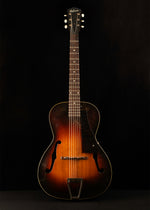
Gibson L-37, SN: 7201H-7
This is a 1942 Gibson L-37, a small body arch top guitar built at a moment when Gibson was just starting to feel the pinch of wartime restrictions in the lead up to World War II. The 1940 Gibson catalog describes the guitar well:
SIZE: 14 ¾” wide and 19 ¼” long.
WOODS: Fine grain spruce top; northern maple back and rim; mahogany neck; rosewood fingerboard.
FINISH: Chocolate brown with golden sunburst on top, rims and back.
TRIMMINGS: Genuine pearl inlays in fingerboard; top and bottom edges of body and fingerrest bound with white ivoroid.
FITTINGS: New type machine heads, nickel plated with white buttons; elevated brown celluloid finger-rest; nickel plated extension tailpiece; white side position marks and endpin; adjustable rosewood bridge; 19 frets.
The white binding on the pickguard would be gone by the time this L-37 was produced and the nickel plated extension tailpiece is no longer an assemblage of brass, replaced by a nickel plated stamped steel affair, presumably due to the unavailability of brass in 1942. Another change from the catalog example is the move to larger F-holes, a change that would persist for most models beyond the end of the war.
Otherwise, it is more or less identical to a late 1930s L-37, it still retains an adjustable truss rod, a feature soon discontinued due to the war, three-on-a-plate Kluson tuners, a stenciled white script logo and a rosewood bridge, though this one has a compensated saddle, a new Gibson feature on higher-end Gibsons of the time and, apparently, this one.
The ebony nut is 1 ¾” wide. The neck depth at the first fret is 15/16” and 1 1/16” at the ninth. The bridge spacing is 2 ⅛.” The frets have been replaced with wider (0.110”) frets than the originals. They show little wear and play beautifully. The white plastic buttons on the tuners have been replaced with excellent copies. There is a strap button installed in the heel and the endpin has been replaced with an endpin jack for an installed undermount piezo-electric pickup.
There is a center seam crack, sealed long ago, under the tailpiece and checking throughout the finish, though it retains much of its original lustre. It is housed in a modern hard shell case.











